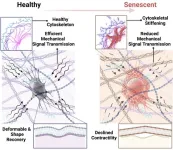(Press-News.org) The viability of hospital-based emergency care in the U.S. is at risk, threatened by issues such as patients with increasingly complex needs and falling payments for physicians, according to a new RAND report.
Many of the problems facing emergency medicine are expanding in scale, including long emergency department wait times, boarding patients in emergency department beds and a high amount of uncompensated care.
The issues are in focus as the use of hospital emergency departments return to levels seen before restrictions prompted by the COVID-19 pandemic limited use of emergency departments, according to researchers.
“Urgent action is needed to sustain hospital emergency departments, which act as a safeguard for patients who use the services and communities that rely on them during a crisis,” said Mahshid Abir, the report’s lead author and a senior physician policy researcher at RAND, a nonprofit research organization. “Unless these challenges are addressed, there is an increasing risk that emergency departments will close, more doctors and nurses will leave emergency medicine, and patients will face even longer waits for care.”
Researchers say a key problem facing hospital-based emergency medicine is that many of the services provided are not directly reimbursed by public or private payors.
Under federal law, all people who arrive at emergency departments must be assessed and stabilized, regardless of their ability to pay. In addition, activities such as coordination for follow-up care, responding to mass casualty incidents and preparing for public health emergencies are not directly reimbursed.
RAND researchers recommend a new, tiered payment model that would build upon the existing payment system to address those shortcomings.
The recommendations include new payments from public and private payors to emergency health care professionals for the public health services not already covered by insurance, such as mental health and infectious disease screening.
Researchers also recommend expanding Medicaid payments directed to hospitals that care for large numbers of uninsured patients and increasing payments from public insurance programs to reduce the gap between private and public reimbursements.
Hospital-based emergency departments have been at the forefront of responding to the opioid and gun violence epidemics, and played a critical role in providing care throughout the COVID-19 pandemic.
Nationally, hospital emergency departments handle 120 to 140 million visits each year, compared with about 1 billion physician office visits annually. The number of hospital emergency departments is declining, with most closures occurring in rural areas.
The RAND study found that the scope of work for emergency physicians in the U.S. health system is expanding, with evidence that emergency departments have become hubs that offer various services beyond emergency care. This expanded focus includes inpatient observation care, hospital-at-home and remote patient-monitoring programs, and emergency department critical care units.
Researchers found that Medicare and Medicaid payments to emergency department physicians fell 3.8% from 2018 to 2022. Reductions in payments for commercially insured patient visits were much steeper, dropping 10.9% for commercial in-network and 48% for commercial out-of-network visits over the period.
The RAND report is based on interviews and focus groups with emergency medicine professionals, a survey of more than 200 emergency medicine department leaders, case studies, a review of other published research, and analysis of administrative data. The study was overseen by a 13-member advisory board that included emergency medicine professionals, emergency care policy experts and other health care experts.
Support for the project was provided by the Emergency Medicine Policy Institute.
The report, “Strategies for Sustaining Emergency Care in the United States,” is available at www.rand.org. Other authors of the report are Brian Briscombe, Carl T. Berdahl, Kirstin W. Scott, Sydney Cortner, Daniel Wang, Rose Kerber and Wilson Nham.
RAND Health Care promotes healthier societies by improving health care systems in the United States and other countries.
END
Viability of hospital-based emergency care in US faces peril
Report finds that reforms needed to boost payments, support workers
2025-04-07
ELSE PRESS RELEASES FROM THIS DATE:
Exposure to air pollution may harm brain health of older adults
2025-04-07
Long-term exposure to high levels of air pollution may harm the brain health of older adults in England, finds a new study led by UCL researchers.
The research, published in The Journals of Gerontology: Series A, found that exposure to nitrogen dioxide (NO₂) and fine particulate matter (PM2.5) is linked to lower scores in key cognitive abilities, particularly language skills.
NO₂ mainly enters the atmosphere through fuel combustion, originating from emissions of vehicles like cars, trucks, and buses, as well as power plants and off-road machinery. PM2.5 pollution in outdoor air often originates from the ...
New study investigates effects of ADHD medications on the heart
2025-04-06
UNDER EMBARGO UNTIL 23.30 UK TIME ON SUNDAY 6TH APRIL 2025
New study investigates effects of ADHD medications on the heart
A new study led by the University of Southampton has found that medications for ADHD have overall small effects on blood pressure and heart rate after weeks or a few months of use.
There have been concerns about the side effects of ADHD medications but the new findings, coupled with other studies, suggest that the benefits of taking these medications outweigh the risks, while highlighting the need for careful monitoring.
The study, published in ...
Research to tackle Prymnesium algal blooms which affect fish populations
2025-04-06
A scientific initiative to combat harmful Prymnesium algal blooms in the Broads is gaining fresh momentum, thanks to a renewed collaboration between the University of East Anglia (UEA), the Environment Agency, the Broads Authority, and the Norfolk pike angling community.
Prymnesium algal blooms can occur on the Broads and produce toxins that threaten fish stocks, local biodiversity, and East Anglia’s thriving angling industry, which contributes more than £100 million annually to the local economy.
The golden algae Prymnesium parvum is therefore of significant research interest to ...
Climate and health litigation mounting in Australia as exposure to heatwaves grows
2025-04-06
Australia’s exposure to extreme heat continues to grow while the country has emerged as a global hotspot for climate change litigation, according to the latest MJA–Lancet Countdown report.
Released today, the report reveals Australia has experienced a 37 per cent increase in excess heat factor over the past 20 years.
Lead author and Director of the Lancet Countdown Centre in Oceania, Professor Paul Beggs from Macquarie University, says these findings underscore the importance of long-term tracking of climate hazards and exposures in Australia.
“The frequency of health-damaging heat has increased substantially since the 1970s," says Professor Beggs.
The ...
Young females more likely to experience higher social anxiety due to excessive smartphone use than other genders
2025-04-06
EMBAROGED UNTIL SUNDAY 6TH APRIL AT 08:00 CEST
YOUNG FEMALES MORE LIKELY TO EXPERIENCE HIGHER SOCIAL ANXIETY DUE TO EXCESSIVE SMARATPHONE USE THAN OTHER GENDERS
Sunday 6th April 08:00 CEST - A new study presented today at the European Psychiatric Association Congress 2025 reveals that gender plays a significant role in excessive and problematic (psychological or behavioural dependence)1 smartphone use, with young females more likely to experience higher social anxiety than other genders. In the study, it was also found that gender was significantly linked to the amount of time spent using smartphones ...
New research boosts future whooping cough vaccines
2025-04-04
Whooping cough, or pertussis, was once a leading cause of death for children in the U.S. and worldwide before the introduction of vaccines in the 1940s. In the decades since, the bacterial disease was nearly eradicated in the U.S., with fatalities falling to double digits each year.
But the disease has made a troubling comeback in recent years as vaccine coverage declined after the COVID-19 pandemic. In 2024, several outbreaks left public health officials and hospitals scrambling to accommodate a sudden influx of patients, primarily infants, who are often too young to be vaccinated and suffer the most severe symptoms.
Now, new research from The University of Texas at Austin could aid ...
Mechanistic understanding could enable better fast-charging batteries
2025-04-04
MADISON — Fast-charging lithium-ion batteries are ubiquitous, powering everything from cellphones and laptops to electric vehicles. They’re also notorious for overheating or catching fire.
Now, with an innovative computational model, a University of Wisconsin–Madison mechanical engineer has gained new understanding of a phenomenon that causes lithium-ion batteries to fail.
Developed by Weiyu Li, an assistant professor of mechanical engineering at UW–Madison, the model explains lithium plating, in which fast charging triggers metallic lithium to build up on the surface of a battery’s anode, causing the battery to ...
No bones about it: new details about skeletal cell aging revealed
2025-04-04
It's no coincidence that our bodies feel a little creakier as we age. The trillions of cells that make up our skeleton age too, and some change in ways that weaken the very structure of our bones.
Scientists and researchers around the globe are investigating a series of mysteries about what happens to our bones over time. In a new study, a team led by The University of Texas at Austin, in collaboration with Mayo Clinic and Cedars-Sinai Medical Center just made a major break in the case. New research found that osteocytes undergo dramatic structural and functional changes ...
UNM scientists discover how nanoparticles of toxic metal used in MRI scans infiltrate human tissue
2025-04-04
University of New Mexico researchers studying the health risks posed by gadolinium, a toxic rare earth metal used in MRI scans, have found that oxalic acid, a molecule found in many foods, can generate nanoparticles of the metal in human tissues.
In a new paper published in the journal Magnetic Resonance Imaging, a team led by Brent Wagner, MD, professor in the Department of Internal Medicine in the UNM School of Medicine, sought to explain the formation of the nanoparticles, which have been associated with serious health problems in the kidneys and other organs.
“The worst disease caused by MRI contrast agents is nephrogenic systemic ...
UMaine research examines best methods for growing Atlantic sea scallops
2025-04-04
A new study from the University of Maine’s Aquaculture Research Institute (ARI) and Darling Marine Center is helping to refine best practices for growing Atlantic sea scallops (Placopecten magellanicus), a species of increasing interest to Maine’s aquaculture sector.
Published in the academic journal Aquaculture, the research compares two scallop farming methods, ear-hanging and lantern net culture, over a complete grow-out cycle to determine which approach yields the best results for commercial growers. The study, led by UMaine ...
LAST 30 PRESS RELEASES:
COVID-19 leaves a lasting mark on the human brain
Scientists use ultrasound to soften and treat cancer tumors without damaging healthy tissue
Community swimming program for Black youth boosts skills, sense of belonging, study finds
Specific depressive symptoms in midlife linked to increased dementia risk
An ‘illuminating’ design sheds light on cholesterol
Who is more likely to get long COVID?
Study showcases resilience and rapid growth of “living rocks”
Naval Research Lab diver earns Office of Naval Research 2025 Sailor of the Year
New Mayo-led study establishes practical definition for rapidly progressive dementia
Fossil fuel industry’s “climate false solutions” reinforce its power and aggravate environmental injustice
Researchers reveal bias in a widely used measure of algorithm performance
Alcohol causes cancer. A study from IOCB Prague confirms damage to DNA and shows how cells defend against it
Hidden viruses in wastewater treatment may shape public health risks, study finds
Unlock the power of nature: how biomass can transform climate mitigation
Biochar reshapes hidden soil microbes that capture carbon dioxide in farmland
Reducing saturated fat intake shows mortality benefit, but only in high-risk individuals
Manta rays create mobile ecosystems, study finds
Study: Mixed results in using lipoic acid to treat progressive multiple sclerosis
Norbert Holtkamp appointed director of Fermi National Accelerator Laboratory
New agentic AI platform accelerates advanced optics design
Biologists discover neurons use physical signals — not electricity — to stabilize communication
Researchers discover that a hormone can access the brain by hitchhiking
University of Oklahoma researcher awarded funding to pursue AI-powered material design
Exploring how the visual system recovers following injury
Support for parents with infants at pediatric check-ups leads to better reading and math skills in elementary school
Kids’ behavioral health is a growing share of family health costs
Day & night: Cancer disrupts the brain’s natural rhythm
COVID-19 vaccination significantly reduces risk to pregnant women and baby
The role of vaccination in maternal and perinatal outcomes associated with COVID-19 in pregnancy
Mayo Clinic smartwatch system helps parents shorten and defuse children's severe tantrums early
[Press-News.org] Viability of hospital-based emergency care in US faces perilReport finds that reforms needed to boost payments, support workers



